Acer Aspire 4230 Service Manual

Aspire 4530/4230 Series
Service Guide
Service guide files and updates are available on the ACER/CSD web; for more information, please refer to http://csd.acer.com.tw
PRINTED IN TAIWAN

Revision History
Please refer to the table below for the updates made on Aspire 4530/4230 Series service guide.
Date |
Chapter |
Updates |
|
|
|
|
|
|
|
|
|
|
|
|
II

Copyright
Copyright © 2008 by Acer Incorporated. All rights reserved. No part of this publication may be reproduced, transmitted, transcribed, stored in a retrieval system, or translated into any language or computer language, in any form or by any means, electronic, mechanical, magnetic, optical, chemical, manual or otherwise, without the prior written permission of Acer Incorporated.
Disclaimer
The information in this guide is subject to change without notice.
Acer Incorporated makes no representations or warranties, either expressed or implied, with respect to the contents hereof and specifically disclaims any warranties of merchantability or fitness for any particular purpose. Any Acer Incorporated software described in this manual is sold or licensed "as is". Should the programs prove defective following their purchase, the buyer (and not Acer Incorporated, its distributor, or its dealer) assumes the entire cost of all necessary servicing, repair, and any incidental or consequential damages resulting from any defect in the software.
Acer is a registered trademark of Acer Corporation. Intel is a registered trademark of Intel Corporation.
Pentium and Pentium II/III are trademarks of Intel Corporation.
Other brand and product names are trademarks and/or registered trademarks of their respective holders.
III

Conventions
The following conventions are used in this manual:
SCREEN MESSAGES |
Denotes actual messages that appear |
|
on screen. |
|
|
NOTE |
Gives bits and pieces of additional |
|
information related to the current |
|
topic. |
|
|
WARNING |
Alerts you to any damage that might |
|
result from doing or not doing specific |
|
actions. |
|
|
CAUTION |
Gives precautionary measures to |
|
avoid possible hardware or software |
|
problems. |
|
|
IMPORTANT |
Reminds you to do specific actions |
|
relevant to the accomplishment of |
|
procedures. |
|
|
IV

Preface
Before using this information and the product it supports, please read the following general information.
1.This Service Guide provides you with all technical information relating to the BASIC CONFIGURATION decided for Acer's "global" product offering. To better fit local market requirements and enhance product competitiveness, your regional office MAY have decided to extend the functionality of a machine (e.g. add-on card, modem, or extra memory capability). These LOCALIZED FEATURES will NOT be covered in this generic service guide. In such cases, please contact your regional offices or the responsible personnel/channel to provide you with further technical details.
2.Please note WHEN ORDERING FRU PARTS, that you should check the most up-to-date information available on your regional web or channel. If, for whatever reason, a part number change is made, it will not be noted in the printed Service Guide. For ACER-AUTHORIZED SERVICE PROVIDERS, your Acer office may have a DIFFERENT part number code to those given in the FRU list of this printed Service Guide. You MUST use the list provided by your regional Acer office to order FRU parts for repair and service of customer machines.
V

VI

Table of Contents
System Specifications |
1 |
Features . . . . . . . . . . . . . . . . . . . . . . . . . . . . . . . . . . . . . . . . . . . . . . . . . . . . . . . . . . . .1 System Block Diagram . . . . . . . . . . . . . . . . . . . . . . . . . . . . . . . . . . . . . . . . . . . . . . . . .4 Your Acer Notebook tour . . . . . . . . . . . . . . . . . . . . . . . . . . . . . . . . . . . . . . . . . . . . . . .5 Front View . . . . . . . . . . . . . . . . . . . . . . . . . . . . . . . . . . . . . . . . . . . . . . . . . . . . . . .5 Closed Front View . . . . . . . . . . . . . . . . . . . . . . . . . . . . . . . . . . . . . . . . . . . . . . . . .6 Left View . . . . . . . . . . . . . . . . . . . . . . . . . . . . . . . . . . . . . . . . . . . . . . . . . . . . . . . .7 Right View . . . . . . . . . . . . . . . . . . . . . . . . . . . . . . . . . . . . . . . . . . . . . . . . . . . . . . .8 Rear View . . . . . . . . . . . . . . . . . . . . . . . . . . . . . . . . . . . . . . . . . . . . . . . . . . . . . . .8 Bottom View . . . . . . . . . . . . . . . . . . . . . . . . . . . . . . . . . . . . . . . . . . . . . . . . . . . . .9 Indicators . . . . . . . . . . . . . . . . . . . . . . . . . . . . . . . . . . . . . . . . . . . . . . . . . . . . . .10 Easy-Launch Buttons . . . . . . . . . . . . . . . . . . . . . . . . . . . . . . . . . . . . . . . . . . . . .10 Touch Pad Basics (with fingerprint reader) . . . . . . . . . . . . . . . . . . . . . . . . . . . . .11 Using the Keyboard . . . . . . . . . . . . . . . . . . . . . . . . . . . . . . . . . . . . . . . . . . . . . . . . . .12 Lock Keys and embedded numeric keypad . . . . . . . . . . . . . . . . . . . . . . . . . . . .12 Windows Keys . . . . . . . . . . . . . . . . . . . . . . . . . . . . . . . . . . . . . . . . . . . . . . . . . .13 Hot Keys . . . . . . . . . . . . . . . . . . . . . . . . . . . . . . . . . . . . . . . . . . . . . . . . . . . . . . .14 Special Key . . . . . . . . . . . . . . . . . . . . . . . . . . . . . . . . . . . . . . . . . . . . . . . . . . . . .15
Using the System Utilities . . . . . . . . . . . . . . . . . . . . . . . . . . . . . . . . . . . . . . . . . . . . . .16 Acer GridVista (dual-display compatible) . . . . . . . . . . . . . . . . . . . . . . . . . . . . . .16 Launch Manager . . . . . . . . . . . . . . . . . . . . . . . . . . . . . . . . . . . . . . . . . . . . . . . . .17 Hardware Specifications and Configurations . . . . . . . . . . . . . . . . . . . . . . . . . . . . . . .18
System Utilities |
29 |
BIOS Setup Utility . . . . . . . . . . . . . . . . . . . . . . . . . . . . . . . . . . . . . . . . . . . . . . . . . . . .29
Navigating the BIOS Utility . . . . . . . . . . . . . . . . . . . . . . . . . . . . . . . . . . . . . . . . .29
Information . . . . . . . . . . . . . . . . . . . . . . . . . . . . . . . . . . . . . . . . . . . . . . . . . . . . .30
Main . . . . . . . . . . . . . . . . . . . . . . . . . . . . . . . . . . . . . . . . . . . . . . . . . . . . . . . . . .31
Advanced . . . . . . . . . . . . . . . . . . . . . . . . . . . . . . . . . . . . . . . . . . . . . . . . . . . . . .32
Security . . . . . . . . . . . . . . . . . . . . . . . . . . . . . . . . . . . . . . . . . . . . . . . . . . . . . . . .35
Boot . . . . . . . . . . . . . . . . . . . . . . . . . . . . . . . . . . . . . . . . . . . . . . . . . . . . . . . . . . .38
Power . . . . . . . . . . . . . . . . . . . . . . . . . . . . . . . . . . . . . . . . . . . . . . . . . . . . . . . . .39
Exit . . . . . . . . . . . . . . . . . . . . . . . . . . . . . . . . . . . . . . . . . . . . . . . . . . . . . . . . . . .41
BIOS Flash Utility . . . . . . . . . . . . . . . . . . . . . . . . . . . . . . . . . . . . . . . . . . . . . . . . . . . .42
Remove HDD/BIOS Utility . . . . . . . . . . . . . . . . . . . . . . . . . . . . . . . . . . . . . . . . . . . . .43
Machine Disassembly and Replacement |
47 |
Disassembly Requirements . . . . . . . . . . . . . . . . . . . . . . . . . . . . . . . . . . . . . . . . . . . |
.47 |
General Information . . . . . . . . . . . . . . . . . . . . . . . . . . . . . . . . . . . . . . . . . . . . . . . . . |
.48 |
Pre-disassembly Instructions . . . . . . . . . . . . . . . . . . . . . . . . . . . . . . . . . . . . . . |
.48 |
Disassembly Process . . . . . . . . . . . . . . . . . . . . . . . . . . . . . . . . . . . . . . . . . . . . . |
48 |
External Module Disassembly Process . . . . . . . . . . . . . . . . . . . . . . . . . . . . . . . . . . . |
49 |
External Modules Disassembly Flowchart . . . . . . . . . . . . . . . . . . . . . . . . . . . . . |
49 |
Removing the Battery Pack . . . . . . . . . . . . . . . . . . . . . . . . . . . . . . . . . . . . . . . . |
50 |
Removing the Express Dummy Card . . . . . . . . . . . . . . . . . . . . . . . . . . . . . . . . . |
51 |
Removing the SD Dummy Card . . . . . . . . . . . . . . . . . . . . . . . . . . . . . . . . . . . . . |
52 |
Removing the Lower Cover . . . . . . . . . . . . . . . . . . . . . . . . . . . . . . . . . . . . . . . . |
53 |
Removing the DIMM Module . . . . . . . . . . . . . . . . . . . . . . . . . . . . . . . . . . . . . . . |
54 |
Removing the WLAN Module . . . . . . . . . . . . . . . . . . . . . . . . . . . . . . . . . . . . . . . |
55 |
Removing the Hard Disk Drive Module . . . . . . . . . . . . . . . . . . . . . . . . . . . . . . . . |
57 |
Removing the Optical Drive Module . . . . . . . . . . . . . . . . . . . . . . . . . . . . . . . . . . |
59 |
Main Unit Disassembly Process . . . . . . . . . . . . . . . . . . . . . . . . . . . . . . . . . . . . . . . . . |
61 |
Main Unit Disassembly Flowchart . . . . . . . . . . . . . . . . . . . . . . . . . . . . . . . . . . . . |
61 |
Removing the Switch Cover . . . . . . . . . . . . . . . . . . . . . . . . . . . . . . . . . . . . . . . . |
63 |
VII

Table of Contents |
|
Removing the Keyboard . . . . . . . . . . . . . . . . . . . . . . . . . . . . . . . . . . . . . . . . . |
. .64 |
Removing the Antenna Cables . . . . . . . . . . . . . . . . . . . . . . . . . . . . . . . . . . . . |
. .65 |
Removing the LCD Module . . . . . . . . . . . . . . . . . . . . . . . . . . . . . . . . . . . . . . . |
. .66 |
Removing the LED Board . . . . . . . . . . . . . . . . . . . . . . . . . . . . . . . . . . . . . . . . |
. .68 |
Removing the Upper Cover . . . . . . . . . . . . . . . . . . . . . . . . . . . . . . . . . . . . . . |
. .69 |
Removing the Launch Board . . . . . . . . . . . . . . . . . . . . . . . . . . . . . . . . . . . . . |
. .72 |
Removing the Speaker Module . . . . . . . . . . . . . . . . . . . . . . . . . . . . . . . . . . . . |
. .73 |
Removing the Finger Print Reader . . . . . . . . . . . . . . . . . . . . . . . . . . . . . . . . . |
. .76 |
Removing the Touch Pad Module . . . . . . . . . . . . . . . . . . . . . . . . . . . . . . . . . . |
. .77 |
Removing the Bluetooth board . . . . . . . . . . . . . . . . . . . . . . . . . . . . . . . . . . . . |
. .78 |
Removing the Mainboard . . . . . . . . . . . . . . . . . . . . . . . . . . . . . . . . . . . . . . . . |
. .80 |
Removing the Modem Module . . . . . . . . . . . . . . . . . . . . . . . . . . . . . . . . . . . . |
. .81 |
Removing the I/O Board . . . . . . . . . . . . . . . . . . . . . . . . . . . . . . . . . . . . . . . . . |
. .82 |
Removing the Thermal/Fan Module . . . . . . . . . . . . . . . . . . . . . . . . . . . . . . . . |
. .83 |
Removing the CPU . . . . . . . . . . . . . . . . . . . . . . . . . . . . . . . . . . . . . . . . . . . . . |
. .84 |
LCD Module Disassembly Process . . . . . . . . . . . . . . . . . . . . . . . . . . . . . . . . . . . . |
. .85 |
LCD Module Disassembly Flowchart . . . . . . . . . . . . . . . . . . . . . . . . . . . . . . . |
. .85 |
Removing the LCD Bezel . . . . . . . . . . . . . . . . . . . . . . . . . . . . . . . . . . . . . . . . |
. .86 |
Removing the Inverter Board . . . . . . . . . . . . . . . . . . . . . . . . . . . . . . . . . . . . . |
. .88 |
Removing the Camera Board . . . . . . . . . . . . . . . . . . . . . . . . . . . . . . . . . . . . . |
. .89 |
Removing the LCD Panel . . . . . . . . . . . . . . . . . . . . . . . . . . . . . . . . . . . . . . . . |
. .90 |
Removing the LCD Brackets and FPC Cable . . . . . . . . . . . . . . . . . . . . . . . . . |
. .91 |
LCD Module Reassembly Procedure . . . . . . . . . . . . . . . . . . . . . . . . . . . . . . . . . . . |
. .92 |
Replacing the LCD Panel . . . . . . . . . . . . . . . . . . . . . . . . . . . . . . . . . . . . . . . . |
. .92 |
Replacing the Camera Module . . . . . . . . . . . . . . . . . . . . . . . . . . . . . . . . . . . . |
. .94 |
Replacing the Inverter Board . . . . . . . . . . . . . . . . . . . . . . . . . . . . . . . . . . . . . |
. .94 |
Replacing the LCD Bezel . . . . . . . . . . . . . . . . . . . . . . . . . . . . . . . . . . . . . . . . |
. .95 |
Main Module Reassembly Procedure . . . . . . . . . . . . . . . . . . . . . . . . . . . . . . . . . . . |
. .96 |
Replacing the CPU . . . . . . . . . . . . . . . . . . . . . . . . . . . . . . . . . . . . . . . . . . . . . |
. .96 |
Replacing the Thermal/Fan Module . . . . . . . . . . . . . . . . . . . . . . . . . . . . . . . . |
. .97 |
Replacing the I/O Board . . . . . . . . . . . . . . . . . . . . . . . . . . . . . . . . . . . . . . . . . |
. .98 |
Replacing the Modem Module . . . . . . . . . . . . . . . . . . . . . . . . . . . . . . . . . . . . |
. .98 |
Replacing the Mainboard . . . . . . . . . . . . . . . . . . . . . . . . . . . . . . . . . . . . . . . . |
. .99 |
Replacing the Bluetooth Board . . . . . . . . . . . . . . . . . . . . . . . . . . . . . . . . . . . . |
. .99 |
Replacing the Touch Pad Module . . . . . . . . . . . . . . . . . . . . . . . . . . . . . . . . . . |
.100 |
Replacing the Finger Print Reader . . . . . . . . . . . . . . . . . . . . . . . . . . . . . . . . . |
.101 |
Replacing the Speaker Module . . . . . . . . . . . . . . . . . . . . . . . . . . . . . . . . . . . . |
.101 |
Replacing the Launch Board . . . . . . . . . . . . . . . . . . . . . . . . . . . . . . . . . . . . . . |
.104 |
Replacing the Upper Cover . . . . . . . . . . . . . . . . . . . . . . . . . . . . . . . . . . . . . . . |
.104 |
Replacing the LED Board . . . . . . . . . . . . . . . . . . . . . . . . . . . . . . . . . . . . . . . . |
.107 |
Replacing the LCD Module . . . . . . . . . . . . . . . . . . . . . . . . . . . . . . . . . . . . . . . |
.107 |
Replacing the Antenna Cables . . . . . . . . . . . . . . . . . . . . . . . . . . . . . . . . . . . . |
.108 |
Replacing the Keyboard . . . . . . . . . . . . . . . . . . . . . . . . . . . . . . . . . . . . . . . . . |
.109 |
Replacing the Switch Cover . . . . . . . . . . . . . . . . . . . . . . . . . . . . . . . . . . . . . . |
.110 |
Replacing the ODD Module . . . . . . . . . . . . . . . . . . . . . . . . . . . . . . . . . . . . . . |
.110 |
Replacing the Hard Disk Drive Module . . . . . . . . . . . . . . . . . . . . . . . . . . . . . . |
.111 |
Replacing the WLAN Module . . . . . . . . . . . . . . . . . . . . . . . . . . . . . . . . . . . . . |
.112 |
Replacing the DIMM Modules . . . . . . . . . . . . . . . . . . . . . . . . . . . . . . . . . . . . . |
.113 |
Replacing the Lower Cover . . . . . . . . . . . . . . . . . . . . . . . . . . . . . . . . . . . . . . . |
.113 |
Replacing the SD Dummy Card . . . . . . . . . . . . . . . . . . . . . . . . . . . . . . . . . . . |
.114 |
Replacing the ExpressCard Dummy Card . . . . . . . . . . . . . . . . . . . . . . . . . . . |
.114 |
Replacing the Battery . . . . . . . . . . . . . . . . . . . . . . . . . . . . . . . . . . . . . . . . . . . |
.114 |
Troubleshooting |
115 |
Common Problems . . . . . . . . . . . . . . . . . . . . . . . . . . . . . . . . . . . . . . . . . . . . . . . . . .115
VIII

Table of Contents
Power On Issue . . . . . . . . . . . . . . . . . . . . . . . . . . . . . . . . . . . . . . . . . . . . . . . .116
No Display Issue . . . . . . . . . . . . . . . . . . . . . . . . . . . . . . . . . . . . . . . . . . . . . . . .117
Random Loss of BIOS Settings . . . . . . . . . . . . . . . . . . . . . . . . . . . . . . . . . . . .118
LCD Failure . . . . . . . . . . . . . . . . . . . . . . . . . . . . . . . . . . . . . . . . . . . . . . . . . . . .119
Built-In Keyboard Failure . . . . . . . . . . . . . . . . . . . . . . . . . . . . . . . . . . . . . . . . .119
Touch Pad Failure . . . . . . . . . . . . . . . . . . . . . . . . . . . . . . . . . . . . . . . . . . . . . . .120
Internal Speaker Failure . . . . . . . . . . . . . . . . . . . . . . . . . . . . . . . . . . . . . . . . . .120
Internal Microphone Failure . . . . . . . . . . . . . . . . . . . . . . . . . . . . . . . . . . . . . . .122
HDD Not Operating Correctly . . . . . . . . . . . . . . . . . . . . . . . . . . . . . . . . . . . . . .123
ODD Failure . . . . . . . . . . . . . . . . . . . . . . . . . . . . . . . . . . . . . . . . . . . . . . . . . . .124
USB Failure (Rightside) . . . . . . . . . . . . . . . . . . . . . . . . . . . . . . . . . . . . . . . . . .127
Modem Function Failure . . . . . . . . . . . . . . . . . . . . . . . . . . . . . . . . . . . . . . . . . .127
Wireless Function Failure . . . . . . . . . . . . . . . . . . . . . . . . . . . . . . . . . . . . . . . . .128
EasyTouch Button Failure . . . . . . . . . . . . . . . . . . . . . . . . . . . . . . . . . . . . . . . . .128
MediaTouch Button Failure . . . . . . . . . . . . . . . . . . . . . . . . . . . . . . . . . . . . . . . .129
Fingerprint Reader Failure . . . . . . . . . . . . . . . . . . . . . . . . . . . . . . . . . . . . . . . .129
Thermal Unit Failure . . . . . . . . . . . . . . . . . . . . . . . . . . . . . . . . . . . . . . . . . . . . .130
HDTV Switch Failure . . . . . . . . . . . . . . . . . . . . . . . . . . . . . . . . . . . . . . . . . . . . .130
External Mouse Failure . . . . . . . . . . . . . . . . . . . . . . . . . . . . . . . . . . . . . . . . . . .131
Other Failures . . . . . . . . . . . . . . . . . . . . . . . . . . . . . . . . . . . . . . . . . . . . . . . . . .131
Intermittent Problems . . . . . . . . . . . . . . . . . . . . . . . . . . . . . . . . . . . . . . . . . . . . . . . .132
Undetermined Problems . . . . . . . . . . . . . . . . . . . . . . . . . . . . . . . . . . . . . . . . . . . . . .132
POST Codes Tables . . . . . . . . . . . . . . . . . . . . . . . . . . . . . . . . . . . . . . . . . . . . . . . . .133
Chipset POST Codes . . . . . . . . . . . . . . . . . . . . . . . . . . . . . . . . . . . . . . . . . . . .133
Core POST Codes . . . . . . . . . . . . . . . . . . . . . . . . . . . . . . . . . . . . . . . . . . . . . .135
Jumper and Connector Locations |
143 |
Top View . . . . . . . . . . . . . . . . . . . . . . . . . . . . . . . . . . . . . . . . . . . . . . . . . . . . . . . . . |
.143 |
Bottom View . . . . . . . . . . . . . . . . . . . . . . . . . . . . . . . . . . . . . . . . . . . . . . . . . . . . . . |
.144 |
Clearing Password Check and BIOS Recovery . . . . . . . . . . . . . . . . . . . . . . . . . . . |
.145 |
Clearing Password Check . . . . . . . . . . . . . . . . . . . . . . . . . . . . . . . . . . . . . . . . |
.145 |
BIOS Recovery by Crisis Disk . . . . . . . . . . . . . . . . . . . . . . . . . . . . . . . . . . . . |
.146 |
FRU (Field Replaceable Unit) List |
147 |
Aspire 4530/4230 Exploded Diagram . . . . . . . . . . . . . . . . . . . . . . . . . . . . . . . . . . . .148
Main Assembly . . . . . . . . . . . . . . . . . . . . . . . . . . . . . . . . . . . . . . . . . . . . . . . . .148
LCD Assembly . . . . . . . . . . . . . . . . . . . . . . . . . . . . . . . . . . . . . . . . . . . . . . . . .149
Aspire 4530/4230 FRU List . . . . . . . . . . . . . . . . . . . . . . . . . . . . . . . . . . . . . . . .150
Model Definition and Configuration |
158 |
Aspire 4530/4230 Series . . . . . . . . . . . . . . . . . . . . . . . . . . . . . . . . . . . . . . . . . . . . |
.159 |
Test Compatible Components |
183 |
Microsoft® Windows® Vista Environment Test . . . . . . . . . . . . . . . . . . . . . . . . . . . |
.184 |
Online Support Information |
187 |
Index |
189 |
IX

Table of Contents
X

Chapter 1
System Specifications
Features
Below is a brief summary of the computer’s many feature:
Operating System
•Windows® Vista™
Platform
•AMD Better By Design program, featuring:
•AMD Turion™ 64 X2 dual-core mobile processor*
•AMD Athlon™ 64 X2 dual-core mobile processor*
•Mobile AMD Sempron™ processor*
•NVIDIA® nForce® MCP77MH
•Acer InviLink™ 802.11b/g
System Memory
•Dual-Channel DDR2 SDRAM support
•Up to 2 GB of DDR2 667 MHz memory, upgradeable to 4 GB using two soDIMM modules
Display and graphics
•14.1" WXGA 1280 x 800
•NVIDIA® GeForce® 9100M G
Storage subsystem
•2.5" hard disk drive
•Optical drive options:
•DVD-Super Multi double-layer drive*
•DVD/CD-RW combo drive*
•5-in-1 card reader
Audio
•Two built-in Acer 3DSonic stereo speakers
•High-definition audio support
•S/PDIF (Sony/Philips Digital Interface) support for digital speakers
•MS-Sound compatible
•Built-in microphone
Chapter 1 |
1 |

Communication
•Acer Video Conference, featuring:
•Integrated Acer Crystal Eye webcam*
•Optional Acer Xpress VoIP phone*
•WLAN: Acer InviLink™ 802.11b/g
•WPAN: Bluetooth® 2.0+EDR
•LAN: Gigabit Ethernet, Wake-on-LAN ready
•Modem: 56K ITU V.92
Privacy Control
•Acer Bio-Protection fingerprint solution*
•BIOS user, supervisor, HDD passwords
•Kensington lock slot
Dimensions
•339 (W) x 243 (D) x 29/39 (H) mm (13.35 x 9.57 x 1.14/1.54 inches)
•2.40 kg (5.29 lbs.)
Power Subsystem
•ACPI 3.0
•48.8W 4400 mAh
•3-pin 65 W AC adapter
•Energy Star 4.0
Special Keys and Controls
•88-/89-/93-key keyboard
•Touch Pad pointing device
I/O Ports
•ExpressCard™/54 slot
•5-in-1 card reader (SD™, MMC, MS, MS PRO, xD)
•3 USB 2.0 ports
•External display (VGA) port
•Headphone/speaker/line-out jack with S/PDIF support
•Microphone-in jack
•Line-in jack
•Ethernet (RJ-45) port
•Modem (RJ-11) port
•DC-in jack for AC adapter
2 |
Chapter 1 |

Environment
•Temperature:
•Operating: 5 °C to 35 °C
•Non-operating: -20 °C to 65 °C
•Humidity (non-condensing):
•Operating: 20% to 80%
•Non-operating: 20% to 80%
NOTE: Items marked with * denote only selected models.
Chapter 1 |
3 |
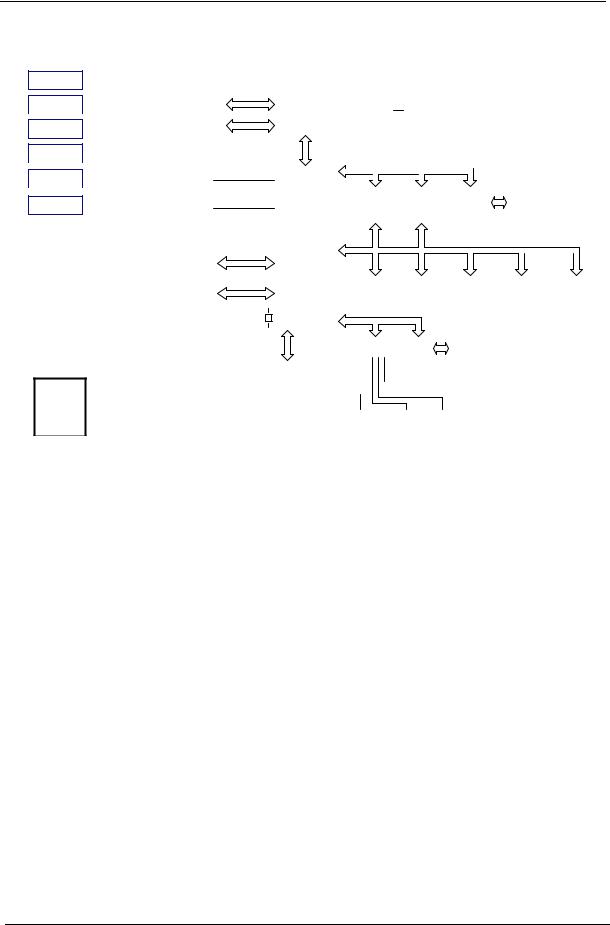
System Block Diagram
CPU CORE / VDDNB (ISL6265A)
NB_CORE +1.1V (RT8202)
+1.1V_NB (RT8202)
DDR II SMDDR_VTERM 1.8VSUS(TPS51116REGR)
SYSTEM POWER (ISL6237)
SYSTEM CHARGER (ISL6251A)
PCB STACK UP
LAYER 1 : TOP
LAYER 2 : GND
LAYER 3 : IN1
LAYER 4 : IN2
LAYER 5 : VCC
LAYER 6 : BOT
|
DDRII-SODIMM1 |
|
DDRII |
667/800 MHz |
|
|
|
|
|
|
|
|
|
|
|
|
|
|
|
|
|
|
|
|
|
|
|
|
|
|
|
|
|
|
|
|
|
|
|
|
|
|
|
|
|
|
||||||||
|
|
|
|
|
|
AMD Griffin |
Lion |
|
|
|
|
|
|
CPU THERMAL |
|
|
|
CPU Fan |
|
|
|
|
|
|
|
|
|
|
|
|
|
|
|
|||||||||||||||||||||
|
|
|
|
|
|
|
|
|
|
|
|
|
Sabie |
|
|
|
|
|
|
SENSOR |
|
|
|
|
|
|
|
|
|
|
|
|
|
|
|
|
|
|
||||||||||||||||
|
|
|
|
|
|
|
|
|
|
|
|
|
|
|
S1G2 Processor |
|
|
|
|
|
|
|
|
|
|
|
|
|
|
|
|
|
|
|
|
|
|
|
|
|
|
|
|
|
|
|
|
|
|
|
||||
|
DDRII-SODIMM2 |
|
DDRII |
667/800 MHz |
|
638P (uPGA)/35W |
|
|
|
|
|
|
|
|
|
|
|
|
|
|
|
|
|
|
|
|
|
|
|
|
|
|
|
|
|
|
|
|
|
|
|
|||||||||||||
|
|
|
|
|
|
|
|
|
|
|
|
|
|
|
|
|
|
|
|
|
|
|
|
|
|
|
|
|
|
|
|
|
|
|
|
|
|
|
|
|
|
|||||||||||||
|
|
|
|
|
|
|
|
|
|
|
|
|
|
|
|
|
|
|
|
|
|
|
|
|
|
|
|
|
|
|
|
|
|
|
|
|
|
|
|
|
|
|
|
|
|
|
|
|
|
|
|
|
|
|
|
|
|
|
|
|
|
|
|
|
|
|
|
|
HT3 |
|
|
|
|
|
|
|
|
|
|
|
|
|
|
|
|
|
|
|
|
|
|
|
|
|
|
|
|
|
|
|
|
|
|
|
|
|
|||
|
|
|
|
|
|
|
|
|
|
|
|
|
|
LINK |
|
|
|
|
|
|
|
|
|
|
|
|
|
|
|
|
|
|
|
|
|
|
|
|
|
|
|
|
|
|
|
|
|
|
|
|
|
|||
|
|
|
|
|
|
|
|
|
|
|
|
|
|
|
|
|
|
|
|
|
|
|
|
|
|
|
|
|
|
|
|
|
|
|
|
|
|
|
|
|
|
|
|
|
|
|
|
|
|
|
|
|
|
|
|
LVDS |
|
|
|
LVDS |
|
|
|
|
|
|
|
|
|
|
|
PCI-E |
|
|
|
|
|
|
|
|
|
|
|
|
|
|
|
|
|
|
|
|
|
|
|||||||||||||||
|
|
|
|
|
|
|
|
|
|
|
|
|
|
|
|
|
|
P CIE4 |
|
|
|
|
|
|
P CIE3 |
|
|
|
P CIE2 |
|
|
|
|
|
|
|||||||||||||||||||
|
|
|
|
|
|
|
|
|
|
|
|
|
|
|
|
|
|
|
|
|
|
|
|
|
|
|
|
|
|
X1 |
|
|
|
|
|
|
|
|
X1 |
|
|
|
X1 |
|
|
|
|
|
|
|||||
|
|
|
|
|
|
|
|
|
|
|
|
|
|
|
|
|
|
|
|
|
|
|
|
|
|
Mini PCI-E |
|
|
|
|
Express |
|
|
|
|
|
|
LAN |
|
|
|
|
|
|
||||||||||
|
|
|
|
|
|
|
|
|
|
|
|
|
|
|
|
|
|
|
|
|
|
|
|
|
|
|
|
|
|
|
|
|
|
|
|
|
|
|
|
|
|
|||||||||||||
|
|
|
|
|
|
|
|
|
|
|
|
|
|
|
|
|
|
|
|
|
|
|
|
|
|
Card |
|
|
|
|
Card |
|
|
|
|
|
|
BRODCOM |
|
RJ45 |
|
|
|
|||||||||||
|
CRT |
|
CRT |
NORTH BRIDGE & |
|
|
|
|
|
|
(Wireless LAN) |
|
|
|
|
(NEW CARD) |
|
|
|
|
BCM8764M |
|
|
|
|
|
|
|||||||||||||||||||||||||||
|
|
|
|
|
|
|
|
|
|
|
|
|
|
|
|
|
|
|
|
|
|
|
|
|
|
(10/100/GagaLAN) |
|
|
|
|
|
|
||||||||||||||||||||||
|
|
|
|
|
|
|
|
|
|
|
|
|
|
|
|
|
|
|
|
|
|
|
|
|
|
|
|
|
|
|
|
|
|
|
|
|
|
|
|
|
|
|
|
|||||||||||
|
|
|
|
|
|
|
|
|
|
|
|
|
SOUTH BRIDGE |
|
|
|
|
|
|
|
|
|
|
|
|
|
|
|
|
|
|
|
|
|
|
|
|
|
|
|
|
|
|
|
||||||||||
|
|
|
|
|
|
|
|
|
|
|
|
|
|
|
|
|
|
|
|
|
|
|
|
|
|
|
|
|
|
|
|
|
|
|
|
|
|
|
|
|
|
|
|
|
|
|
|
|||||||
|
|
|
|
|
|
|
|
|
|
|
|
|
|
|
|
|
|
|
|
|
|
|
|
|
|
|
|
X1 |
|
|
|
|
|
|
X1 |
|
|
|
|
|
|
|
|
|
|
|
|
|
|
|
||||
|
|
|
|
|
|
|
|
|
|
|
|
|
|
MCP77M |
|
|
|
|
|
|
|
|
USB 8 |
|
|
|
|
|
|
USB 5 |
|
|
|
|
|
|
|
|
|
|
||||||||||||||
|
|
|
|
|
|
|
|
|
|
|
|
|
|
|
|
|
USB2.0 |
|
|
|
|
|
|
|
|
|
|
|
|
|
|
|
|
|
|
|
|
|
|
|||||||||||||||
|
SATA - HDD |
|
|
SATA0 |
|
|
|
|
|
|
|
|
|
|
|
|
|
|
|
USB 0,1,7 |
|
|
|
|
USB 6 |
|
|
USB 3 |
|
|
USB 10 |
|
USB 2 |
|||||||||||||||||||||
|
|
|
|
|
|
|
|
|
|
|
|
|
|
|
|
|
|
|
|
|
X3 |
|
|
|
|
|
|
X1 |
|
|
|
|
|
|
|
X1 |
|
|
X1 |
|
X1 |
|||||||||||||
|
|
|
|
|
|
|
|
|
|
|
|
|
|
27mm X 27mm, |
|
|
|
|
|
|
|
|
|
|
|
|
|
|
|
|
|
|
|
|
|
|
|
|
||||||||||||||||
|
|
|
|
|
|
|
|
|
|
|
|
|
|
|
|
|
|
|
|
|
|
|
|
|
|
|
|
|
|
|
|
|
|
|
|
|
|
|
|
|
|
|
|
|
|
|
|
|
||||||
|
|
|
|
|
|
|
|
|
|
|
|
|
|
836pin BGA |
|
|
|
|
|
|
|
|
|
|
|
|
|
|
|
|
|
|
|
|
|
|
|
|
|
|
|
|
|
|
|
|
|
|
|
|
|
|||
|
|
|
|
|
|
|
|
|
|
|
|
|
|
|
|
|
|
|
|
|
|
|
|
|
|
USB2.0 Ports |
|
|
|
|
Bluetooth |
|
|
|
PC-cam |
|
Fingerprint |
|
Card Reader |
|||||||||||||||
|
ODD(SATA) |
|
|
|
|
|
|
|
|
|
|
|
|
|
|
|
|
|
|
|
|
|
|
|
|
|
|
|
|
|
|
|
|
|
|
|
|
|
|
|
|
|
|
|
|
|
|
|
|
|
Realtek |
|||
|
|
|
SATA1 |
|
|
|
|
|
|
|
|
|
|
|
|
|
|
|
|
|
|
|
|
|
|
|
|
|
|
|
|
|
|
|
|
|
|
|
|
|
|
|
|
RTS5158E |
||||||||||
|
|
|
|
|
|
|
|
|
|
|
|
|
|
|
|
|
|
|
|
|
|
|
|
|
|
|
|
|
|
|
|
|
|
|
|
|
|
|
|
|
|
|
|
|
|
|||||||||
|
|
|
|
|
|
|
|
|
14.318MHz |
|
|
|
|
|
|
|
|
|
|
|
|
|
Azalia |
|
|
|
|
|
|
|
|
|
|
|
|
|
|
|
|
|
|
|
|
(7 in 1) |
||||||||||
|
|
|
|
|
|
|
|
|
|
|
|
|
|
|
|
|
|
|
|
|
|
|
|
|
|
|
|
|
|
|
|
|
|
|
|
|
|
|
|
|
|
|
|
|||||||||||
|
|
|
|
|
|
|
|
|
|
|
|
|
|
|
|
|
|
|
|
|
|
|
|
|
|
|
|
|
|
|
|
|
|
|
|
|
|
|
|
|
|
|
||||||||||||
|
|
|
|
|
|
|
|
|
|
|
|
|
|
|
|
|
|
|
|
|
|
|
|
|
|
|
|
|
|
|
|
|
|
|
|
|
|
|
|
|
|
|||||||||||||
|
|
|
|
|
|
|
|
|
|
|
|
|
|
|
|
|
|
|
|
|
|
|
|
|
|
|
|
|
|
|
|
|
|
|
|
|
|
|
|
|
|
|
|
|
|
|
|
|
|
|
|
|
|
|
|
|
|
|
|
|
|
|
|
|
|
|
|
|
|
|
|
|
|
|
|
|
|
|
|
|
|
|
|
|
|
|
|
|
|
|
|
|
|
|
|
|
|
|
|
|
|
|
|
|
|
|
|||
|
|
|
|
|
|
|
|
|
|
|
|
LPC |
|
|
|
|
Azalia AudioController |
|
|
|
MDC 1.5 |
|
|
|
|
|
|
RJ11 |
|
|
|
|
|
|
|
|||||||||||||||||||
|
|
|
|
|
|
|
|
|
|
|
|
|
|
|
|
RealTek ALC268 |
|
|
|
|
|
|
|
|
|
|
|
|
|
|
|
|
|
|
|
|
|
|||||||||||||||||
|
|
|
|
|
|
|
|
|
|
|
|
|
|
|
|
|
|
|
|
|
|
|
|
|
|
|
|
|
|
|
|
|
|
|
|
|
|
|
|
|
|
|
|
|
|
|
|
|
|
|
|
|
|
|
|
|
|
|
|
|
|
|
|
|
|
KBC |
|
|
|
|
|
|
|
|
|
|
|
|
|
|
|
|
|
|
|
|
|
|
|
|
|
|
|
|
|
|
|
|
|
|
|
|
|
|
|
||||
|
|
Keyboard |
|
|
|
|
|
|
|
|
|
|
|
|
|
|
|
|
|
|
|
|
|
|
|
|
|
|
|
|
|
|
|
|
|
|
|
|
|
|
|
|
|
|
|
|
||||||||
|
|
|
|
|
|
|
|
|
(WPCE775C) |
|
|
|
|
|
|
|
|
|
|
|
|
|
|
|
|
|
|
|
|
|
|
|
|
|
|
|
|
|
|
|
|
|
|
|
|
|
|
|
||||||
|
|
|
|
|
|
|
|
|
|
|
|
|
|
|
|
|
|
|
Audio |
|
|
|
|
|
|
|
Int MIC |
|
|
|
|
|
|
|
|
|
|
|
|
|
|
|
||||||||||||
|
|
|
|
|
|
|
|
|
|
|
|
|
|
|
|
|
|
|
Amplifier |
|
|
|
|
|
|
|
|
|
|
|
|
|
|
|
|
|
|
|
|
|
|
|
|
|||||||||||
|
|
|
|
|
|
|
|
|
|
|
|
|
|
|
|
|
|
|
|
|
|
|
|
|
|
|
|
|
|
|
|
|
|
|
|
|
|
|
|
|
|
|
|
|
||||||||||
|
|
|
|
|
|
|
|
|
|
|
|
|
|
|
|
|
|
|
|
|
|
|
|
|
|
|
|
|
|
|
|
|
|
|
|
|
|
|
|
|
|
|
|
|
|
|
|
|
|
|
|
|
|
|
|
|
|
|
|
|
|
Touch Pad |
|
SPI ROM |
|
Speaker |
|
|
|
SPIDF/Phone |
|
|
|
Line in |
|
|
MIC Jack |
|
|
|
|
|
|
|
|
|
|
||||||||||||||||||||||
|
|
|
|
|
|
|
|
|
|
|
|
Jack |
|
|
|
|
|
|
|
|
|
|
|
|
|
|
|
|||||||||||||||||||||||||||
|
|
|
|
|
|
|
|
|
|
|
|
|
|
|
|
|
|
|
|
|
|
|
|
|
|
|
|
|
|
|
|
|
|
|
|
|
|
|
|
|
|
|
|
|
|
|
|
|
|
|||||
|
|
|
|
|
|
|
|
|
|
|
|
|
|
|
|
|
|
|
|
|
|
|
|
|
|
|
|
|
|
|
|
|
|
|
|
|
|
|
|
|
|
|
|
|
|
|
|
|
|
|
|
|
|
|
|
|
|
|
|
|
|
|
|
|
|
|
|
|
|
|
|
|
|
|
|
|
|
|
|
|
|
|
|
|
|
|
|
|
|
|
|
|
|
|
|
|
|
|
|
|
|
|
|
|
|
|
|
|
|
4 |
Chapter 1 |
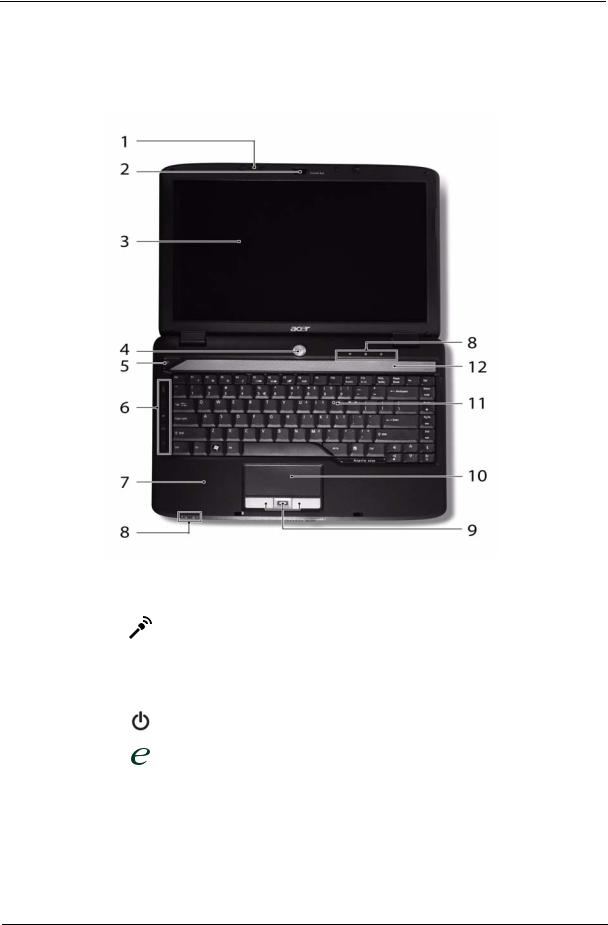
Your Acer Notebook tour
After knowing your computer features, let us show you around your new computer.
Front View
No. |
Icon |
Item |
Description |
|
|
|
|
1 |
|
Microphone |
Internal microphone for sound recording. |
|
|
|
|
2 |
|
Acer Crystal Eye |
Web camera for video communication. |
|
|
|
|
3 |
|
Display screen |
Also called Liquid-Crystal Display (LCD), |
|
|
|
displays computer output. |
|
|
|
|
4 |
|
Power button |
Turns the computer on and off. |
|
|
|
|
5 |
|
Empowering key |
Launch Acer Empowering Technology |
|
|
|
|
6 |
|
Easy-launch |
Buttons for launching frequently used program. |
|
|
buttons |
|
7 |
|
Palmrest |
Comfortable support area for your hands when |
|
|
|
you use the computer. |
|
|
|
|
8 |
|
Status indicators |
Light-Emitting Diodes (LEDs) that light up to |
|
|
|
show the status of the computer's functions |
|
|
|
and components. |
Chapter 1 |
5 |

No. |
Icon |
Item |
Description |
|
|
|
|
9 |
|
Click buttons |
The left and right buttons function like the left |
|
|
(left, center* and |
and right mouse buttons. *The center button |
|
|
right) |
serves as Acer Bio-Protection fingerprint |
|
|
|
reader supporting Acer FingerNav 4-way |
|
|
|
control function. |
|
|
|
|
10 |
|
Touch Pad |
Touch-sensitive pointing device which functions |
|
|
|
like a computer mouse. |
|
|
|
|
11 |
|
Keyboard |
For entering data into your computer. |
|
|
|
|
12 |
|
Speakers |
Left and right speakers deliver stereo audio |
|
|
|
output. |
|
|
|
|
Closed Front View
No. |
Icon |
Item |
Description |
|
|
|
|
1 |
|
5-in-1 card |
Accepts Secure Digital (SD), MultiMediaCard |
|
|
reader |
(MMC), Memory Stick (MS), Memory Stick |
|
|
|
PRO (MS PRO), xD-Picture Card (xD). |
|
|
|
Note: Only one card can operate at any given |
|
|
|
time. |
2 |
|
Unlimited volume |
Adjust the volume of the audio-out. |
|
|
control wheel |
|
|
|
|
|
3 |
|
Latch |
Locks and releases the lid |
|
|
|
|
6 |
Chapter 1 |
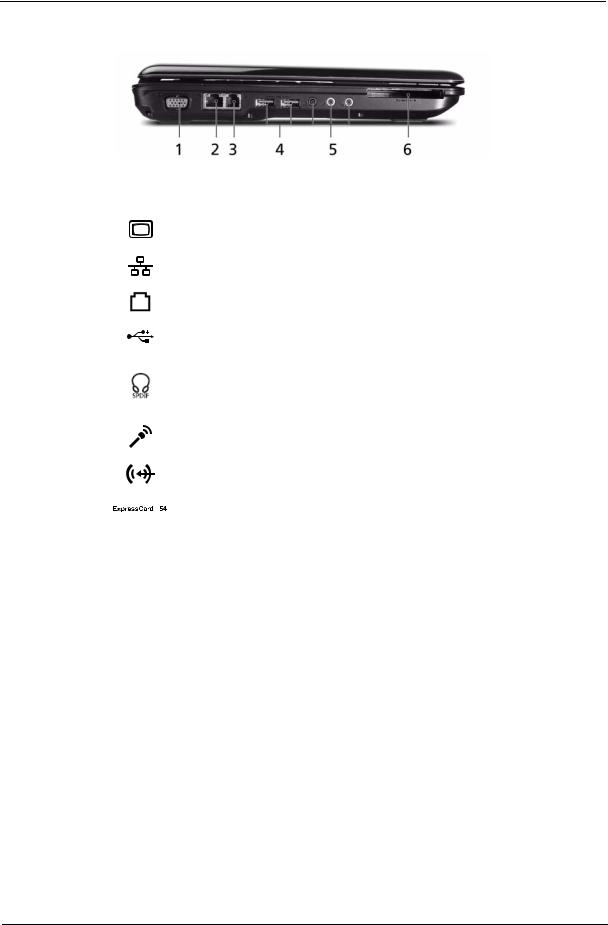
Left View
No. |
Icon |
Item |
Description |
|
|
|
|
1 |
|
External display |
Connects to a display device |
|
|
(VGA) port |
(e.g. external monitor, LCD projector). |
|
|
|
|
2 |
|
Ethernet (RJ-45) |
Connects to an Ethernet 10/100/1000-based |
|
|
port |
network. |
|
|
|
|
3 |
|
Modem (RJ-11) |
Connects to a phone line. |
|
|
port |
|
|
|
|
|
4 |
|
USB 2.0 ports |
Connect to USB 2.0 devices (e.g. USB mouse, |
|
|
|
USB camera). |
|
|
|
|
5 |
|
Headphones/ |
Connects to audio line-out devices |
|
|
speaker/line-out |
(e.g. speakers, headphones). |
|
|
jack with S/PDIF |
|
|
|
support |
|
|
|
|
|
|
|
Microphone-in |
Accepts input from external microphones. |
|
|
jack |
|
|
|
|
|
|
|
Line-in jack |
Accepts audio line-in devices (e.g. audio CD |
|
|
|
player, stereo walkman). |
|
|
|
|
6 |
|
ExpressCard/54 |
Accepts one ExpressCard/54 module. |
|
|
slot |
|
|
|
|
|
Chapter 1 |
7 |
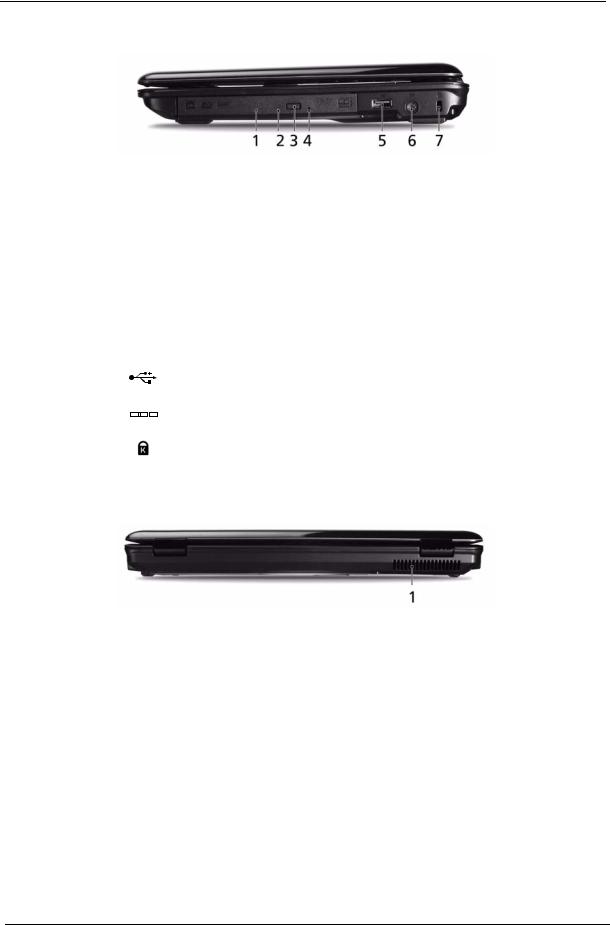
Right View
No. |
|
Icon |
Item |
Description |
|||||
|
|
|
|
|
|
|
|
|
|
1 |
|
|
|
|
|
|
|
Optical drive |
Internal optical drive; accepts CDs or DVDs. |
|
|
|
|
|
|
|
|
|
|
2 |
|
|
|
|
|
|
|
Optical disk access |
Lights up when the optical drive is active. |
|
|
|
|
|
|
|
|
indicator |
|
3 |
|
|
|
|
|
|
|
Optical drive eject |
Ejects the optical disk from the drive. |
|
|
|
|
|
|
|
|
button |
|
|
|
|
|
|
|
|
|
|
|
4 |
|
|
|
|
|
|
|
Emergency eject |
Ejects the optical drive tray when the computer is |
|
|
|
|
|
|
|
|
hole |
turned off. Note: Insert a paper clip into the |
|
|
|
|
|
|
|
|
|
emergency eject hole to eject the optical drive |
|
|
|
|
|
|
|
|
|
tray when the computer is off. |
|
|
|
|
|
|
|
|
|
|
5 |
|
|
|
|
|
|
|
USB 2.0 port |
Connect to USB 2.0 devices (e.g. USB mouse, |
|
|
|
|
|
|
|
|
|
USB camera). |
|
|
|
|
|
|
|
|
|
|
6 |
|
|
|
|
|
|
|
DC-in jack |
Connects to an AC adapter |
|
|
|
|
|
|
|
|||
|
|
|
|
|
|
|
|||
|
|
|
|
|
|
|
|
|
|
7 |
|
|
|
|
|
|
|
Kensington lock |
Connects to a Kensington-compatible computer |
|
|
|
|
|
|
|
|
slot |
security lock. |
|
|
|
|
|
|
|
|
|
|
Rear View
No. |
Icon |
Item |
Description |
|
|
|
|
1 |
|
Ventilation slots |
Enable the computer to stay cool, even after |
|
|
|
prolonged use. |
|
|
|
|
8 |
Chapter 1 |
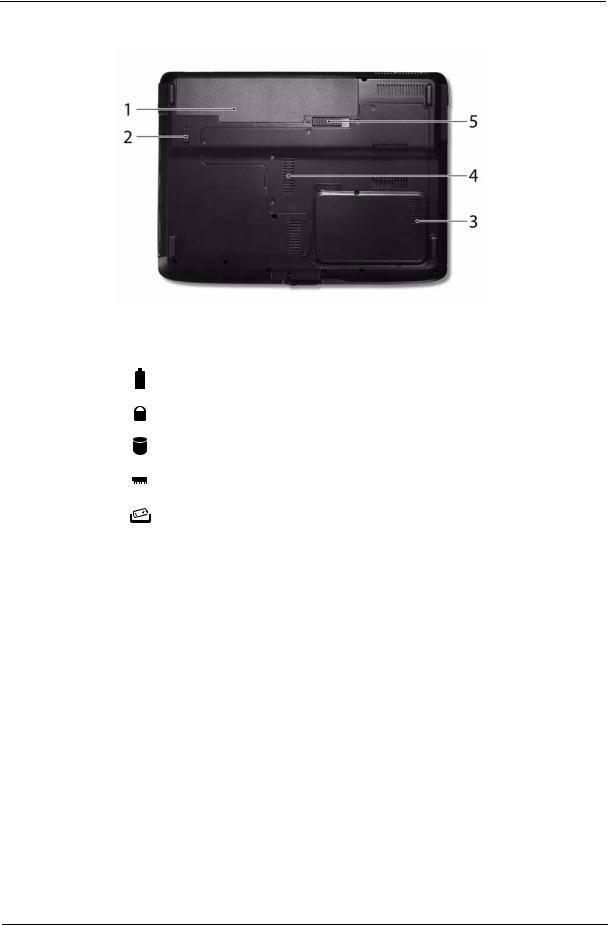
Bottom View
No. |
Icon |
Item |
Description |
||
|
|
|
|
|
|
1 |
|
|
|
Battery bay |
Houses the computer's battery pack. |
|
|
|
|||
|
|
|
|
|
|
|
|
|
|
|
|
2 |
|
|
|
Battery lock |
Locks the battery in position. |
|
|
|
|
|
|
3 |
|
|
|
Hard disk bay |
Houses the computer's hard disk (secured with |
|
|
|
|
|
screws). |
4 |
|
|
|
Memory |
Houses the computer's main memory. |
|
|
|
|
compartment |
|
|
|
|
|
|
|
5 |
|
|
|
Battery release |
Releases the battery for removal. |
|
|
|
|
latch |
|
|
|
|
|
|
|
Chapter 1 |
9 |

Indicators
The computer has several easy-to-read status indicators. The front panel indicators are visible even when the computer cover is closed.
Icon |
Function |
Description |
|||
|
|
|
|
|
|
|
|
|
|
Power |
Indicates the computer's power status. |
|
|
|
|
|
|
|
|
|
|
Battery |
Indicates the computer's battery status. |
|
|
|
|
||
|
|
|
|
|
|
|
|
|
|
|
|
|
|
|
|
HDD |
Indicates when the hard disk drive is active. |
|
|
|
|
|
|
|
|
|
|
Num Lock |
Lights up when Num Lock is activated. |
|
|
|
|
|
|
|
|
|
|
|
|
|
|
|
|
Caps Lock |
Lights up when Caps Lock is activated. |
|
|
|
|
|
|
NOTE: 1. Charging: The light shows amber when the battery is charging. 2. Fully charged: The light shows green when in AC mode.
Easy-Launch Buttons
Located beside the keyboard are application buttons. These buttons are called easy-launch buttons. They are: WLAN, Internet, email, Bluetooth, Arcade and Acer Empowering Technology.
The mail and Web browser buttons are pre-set to email and Internet programs, but can be reset by users. To set the Web browser, mail and programmable buttons, run the Acer Launch Manager.
Icon |
Function |
Description |
|
|
|
|
Empowering Technology |
Launch Acer Empowering Technology. |
|
|
(user-programmable) |
|
|
|
|
Acer Arcade |
Launch Acer Arcade utility |
|
|
|
|
Wireless communication |
Enables/disables the wireless function. Indicates |
|
button/indicator |
the status of wireless LAN communication. |
|
|
|
|
Web browser |
Internet browser (user-Programmable) |
|
|
|
|
Email application (user-Programmable) |
|
|
|
|
|
Bluetooth communication |
Enables/disables the Bluetooth function. Indicates |
|
button/indicator |
the status of Bluetooth communication. |
|
|
|
10 |
Chapter 1 |
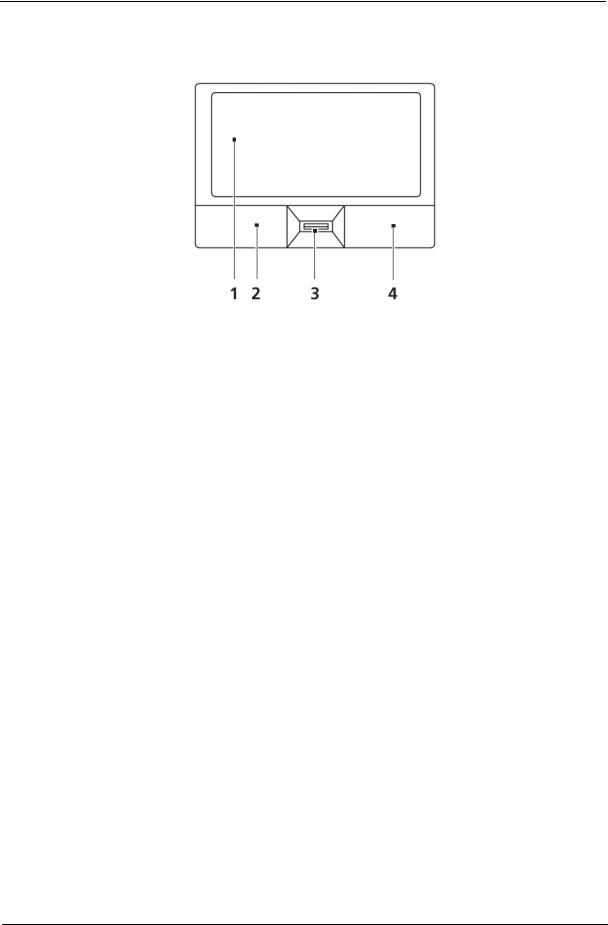
Touch Pad Basics (with fingerprint reader)
The following items show you how to use the Touch Pad with Acer Bio-Protection fingerprint reader:
•Move your finger across the Touch Pad (2) to move the cursor.
•Press the left (1) and right (4) buttons located beneath the Touch Pad to perform selection and execution functions. These two buttons are similar to the left and right buttons on a mouse. Tapping on the Touch Pad is the same as clicking the left button.
•Use Acer Bio-Protection fingerprint reader (3) supporting Acer FingerNav 4-way control function (only for certain models) or the 4-way scroll (3) button (only for certain models) to scroll up or down and move left or right a page. This fingerprint reader or button mimics your cursor pressing on the right scroll bar of Windows applications.
Function |
Left Button (1) |
Right Button (3) |
Main Touch Pad (2) |
|
|
|
|
Execute |
Quickly click twice. |
|
Tap twice (at the same speed |
|
|
|
as double-clicking a mouse |
|
|
|
button). |
|
|
|
|
Select |
Click once. |
|
Tap once. |
|
|
|
|
Drag |
Click and hold, then use |
|
Tap twice (at the same speed |
|
finger on the Touch Pad to |
|
as double-clicking a mouse |
|
drag the cursor. |
|
button); rest your finger on |
|
|
|
the Touch Pad on the second |
|
|
|
tap and drag the cursor. |
|
|
|
|
Access |
|
Click once. |
|
context menu |
|
|
|
|
|
|
|
NOTE: When using the Touch Pad, keep it - and your fingers - dry and clean. The Touch Pad is sensitive to finger movement; hence, the lighter the touch, the better the response. Tapping too hard will not increase the Touch Pad’s responsiveness.
Chapter 1 |
11 |
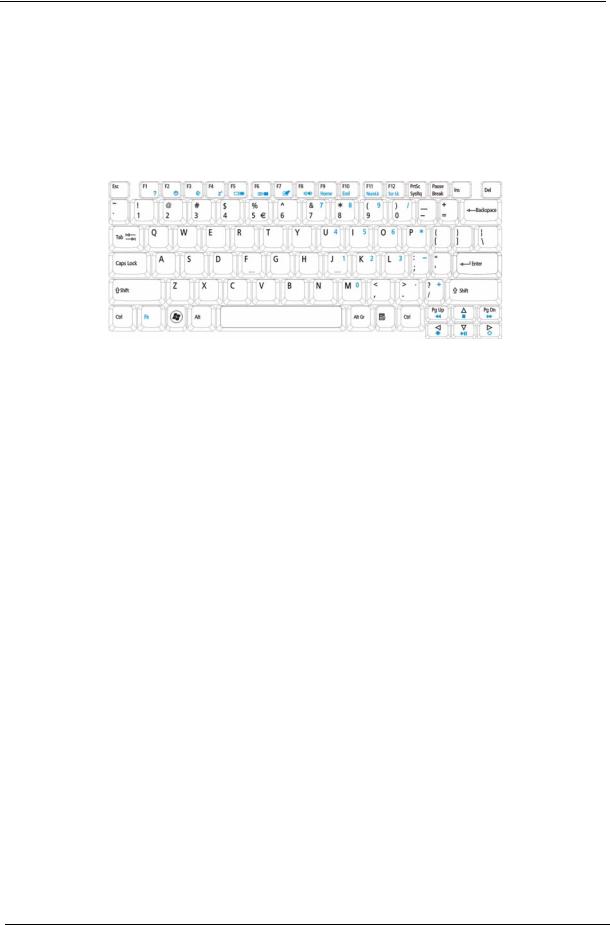
Using the Keyboard
The keyboard has full-sized keys and an embedded numeric keypad, separate cursor, lock, Windows, function and special keys.
Lock Keys and embedded numeric keypad
The keyboard has three lock keys which you can toggle on and off.
Lock key |
Description |
|
|
Caps Lock |
When Caps Lock is on, all alphabetic characters typed are in uppercase. |
Num Lock |
When Num Lock is on, the embedded keypad is in numeric mode. The keys |
<Fn> + <F11> |
function as a calculator (complete with the arithmetic operators +, -, *, and /). Use |
|
this mode when you need to do a lot of numeric data entry. A better solution |
|
would be to connect an external keypad. |
Scroll Lock <Fn> + |
When Scroll Lock is on, the screen moves one line up or down when you press |
<F12> |
the up or down arrow keys respectively. Scroll Lock does not work with some |
|
applications. |
|
|
The embedded numeric keypad functions like a desktop numeric keypad. It is indicated by small characters located on the upper right corner of the keycaps. To simplify the keyboard legend, cursor-control key symbols are not printed on the keys.
Desired access |
Num Lock on |
Num Lock off |
|
|
|
Number keys on |
Type numbers in a normal manner. |
|
embedded keypad |
|
|
|
|
|
Cursor-control keys on |
Hold <Shift> while using cursor- |
Hold <Fn> while using cursor- |
embedded keypad |
control keys. |
control keys. |
|
|
|
Main keyboard keys |
Hold <Fn> while typing letters on |
Type the letters in a normal |
|
embedded keypad. |
manner. |
12 |
Chapter 1 |
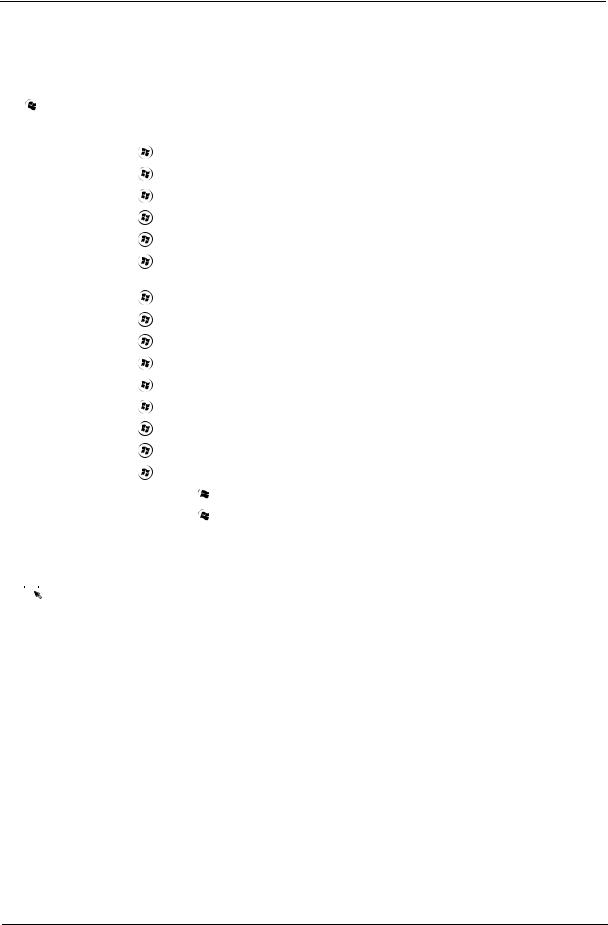
Windows Keys
The keyboard has two keys that perform Windows-specific functions.
|
|
|
Key |
Description |
|
|
|
|
|
|
|
|
Windows key |
Pressed alone, this key has the same effect as clicking on the Windows Start button; |
|
|
|
|
it launches the Start menu. It can also be used with other keys to provide a variety of |
|
|
|
|
functions: |
|
|
|
|
< >:Open or close the Start menu |
|
|
|
|
< > + <D>: Display the desktop |
|
|
|
|
< > + <E>: Open Windows Explore |
|
|
|
|
< > + <F>: Search for a file or folder |
|
|
|
|
< > + <G>: Cycle through Sidebar gadgets |
|
|
|
|
< > + <L>: Lock your computer (if you are connected to a network domain), or |
|
|
|
|
switch users (if you're not connected to a network domain) |
|
|
|
|
< > + <M>: Minimizes all windows |
|
|
|
|
< > + <R>: Open the Run dialog box |
|
|
|
|
< > + <T>: Cycle through programs on the taskbar |
|
|
|
|
< > + <U>: Open Ease of Access Center |
|
|
|
|
< > + <X>: Open Windows Mobility Center |
|
|
|
|
< > + <BREAK>: Display the System Properties dialog box |
|
|
|
|
< > + <SHIFT+M>: Restore minimized windows to the desktop |
|
|
|
|
< > + <TAB>: Cycle through programs on the taskbar by using Windows Flip 3-D |
|
|
|
|
< > + <SPACEBAR>: Bring all gadgets to the front and select Windows Sidebar |
|
|
|
|
<CTRL> + < > + <F>: Search for computers (if you are on a network) |
|
|
|
|
<CTRL> + < > + <TAB>: Use the arrow keys to cycle through programs on the |
|
|
|
|
taskbar by using Windows Flip 3-D |
|
|
|
|
Note: Depending on your edition of Windows Vista, some shortcuts may not function |
|
|
|
|
as described. |
|
|
|
Application |
This key has the same effect as clicking the right mouse button; it opens the |
|
|
|
||
|
|
|
key |
application's context menu. |
|
|
|
||
|
|
|
|
|
Chapter 1 |
13 |
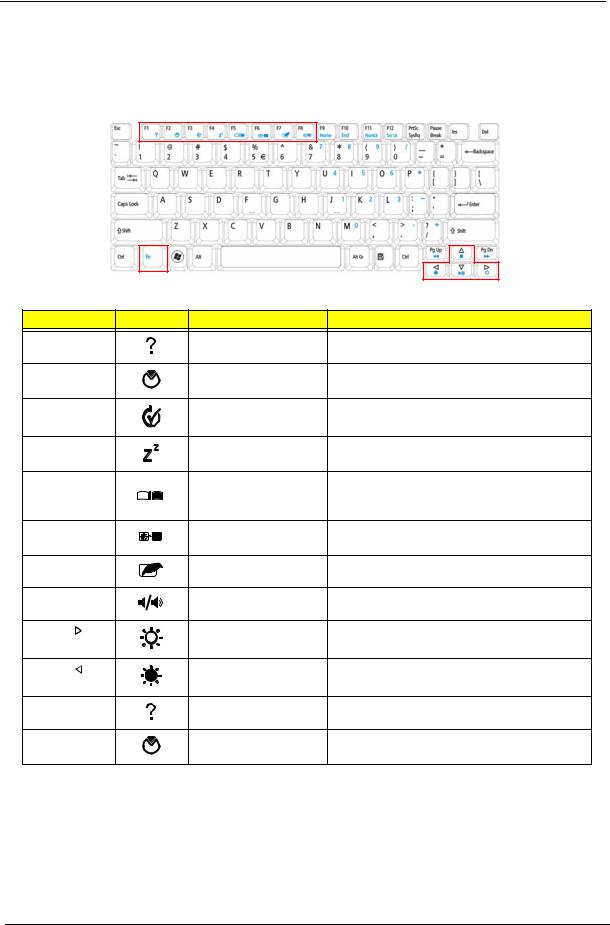
Hot Keys
The computer employs hotkeys or key combinations to access most of the computer’s controls like screen brightness, volume output and the BIOS utility.
To activate hot keys, press and hold the <Fn> key before pressing the other key in the hotkey combination.
Hotkey |
Icon |
Function |
Description |
|
<Fn> + <F1> |
|
Hotkey help |
Displays help on hotkeys. |
|
<Fn> + <F2> |
|
Acer eSettings |
Launches Acer eSettings Management in Acer |
|
|
|
|
Management |
Empowering Technology. |
<Fn> + <F3> |
|
Acer ePower |
Launches Acer ePower Management in Acer |
|
|
|
|
Management |
Empowering Technology. |
<Fn> + <F4> |
|
Sleep |
Puts the computer in Sleep mode. |
|
<Fn> + <F5> |
|
Display toggle |
Switches display output between the display |
|
|
|
|
|
screen, external monitor (if connected) and |
|
|
|
|
both. |
<Fn> + <F6> |
|
Screen blank |
Turns the display screen backlight off to save |
|
|
|
|
|
power. Press any key to return. |
<Fn> + <F7> |
|
Touch Pad toggle |
Turns the internal Touch Pad on and off. |
|
<Fn> + <F8> |
|
Speaker toggle |
Turns the speakers on and off. |
|
<Fn> + < |
> |
|
Brightness up |
Increases the screen brightness. |
<Fn> + < |
> |
|
Brightness down |
Decreases the screen brightness. |
<Fn> + <F1> |
|
Hotkey help |
Displays help on hotkeys. |
|
<Fn> + <F2> |
|
Acer eSettings |
Launches Acer eSettings Management in Acer |
|
|
|
|
Management |
Empowering Technology. |
14 |
Chapter 1 |
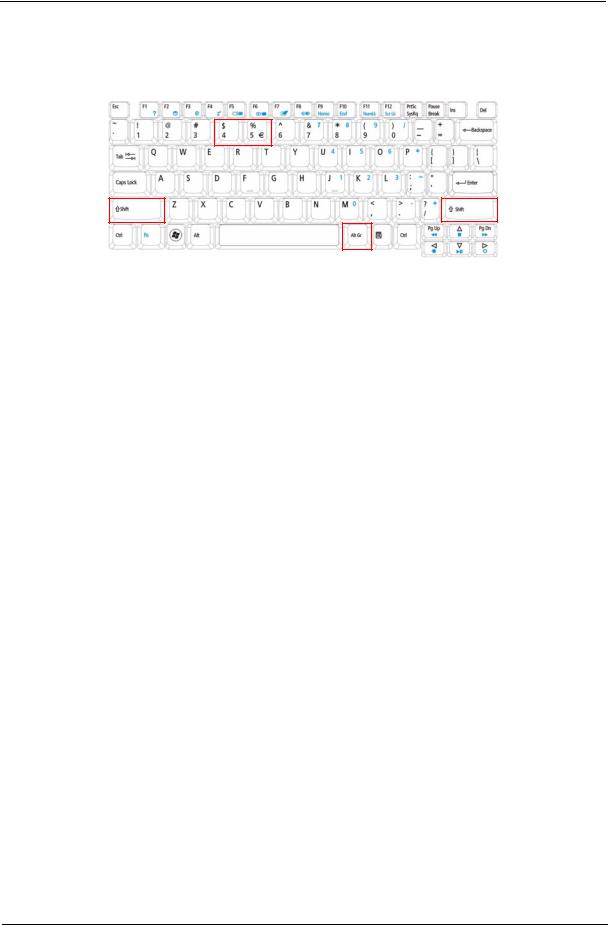
Special Key
You can locate the Euro symbol and the US dollar sign at the upper-center and/or bottom-right of your keyboard.
The Euro symbol
1.Open a text editor or word processor.
2.Hold <Alt Gr> and then press the <5> key at the upper-center of the keyboard.
NOTE: Note: Some fonts and software do not support the Euro symbol. Please refer to www.microsoft.com/ typography/faq/faq12.htm for more information.
The US dollar sign
1.Open a text editor or word processor.
2.Hold <Shift> and then press the <4> key at the upper-center of the keyboard. NOTE: This function varies by the operating system version.
Chapter 1 |
15 |
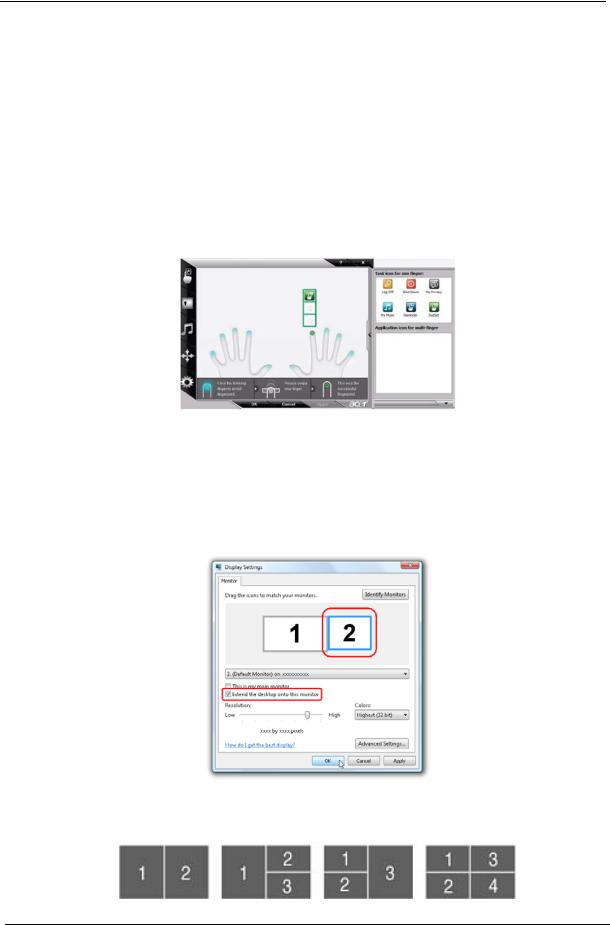
Using the System Utilities
Acer Bio-Protection (only for certain models) Acer Bio-Protection Fingerprint Solution is a multi-purpose fingerprint software package integrated with the Microsoft Windows operating system. Utilizing the uniqueness of one's fingerprint features, Acer Bio-Protection Fingerprint Solution has incorporated protection against unauthorized access to your computer with centralized password management with Password Bank, easy music player launching with Acer MusicLaunch, secure Internet favorites via Acer MyLaunch, and fast application/website launching and login with Acer FingerLaunch, while Acer ProfileLaunch can launch up to three applications/websites from a single finger swipe.
Acer Bio-Protection Fingerprint Solution also allows you to navigate through web browsers and documents using Acer FingerNav. With Acer Bio-Protection Fingerprint Solution, you can now enjoy an extra layer of protection for your personal computer, as well as the convenience of accessing your daily tasks with a simple swipe of your finger!
For more information refer to the Acer Bio-Protection help files.
Acer GridVista (dual-display compatible)
NOTE: This feature is only available on certain models.
To enable the dual monitor feature of the notebook, first ensure that the second monitor is connected, then select Start, Control Panel, Display and click on Settings. Select the secondary monitor (2) icon in the display box and then click the check box Extend my windows desktop onto this monitor. Finally, click Apply to confirm the new settings and click OK to complete the process.
Acer GridVista is a handy utility that offers four pre-defined display settings so you can view multiple windows on the same screen. To access this function, please go to Start´ All Programs and click on Acer GridVista. You may choose any one of the four display settings indicated below:
16 |
Chapter 1 |
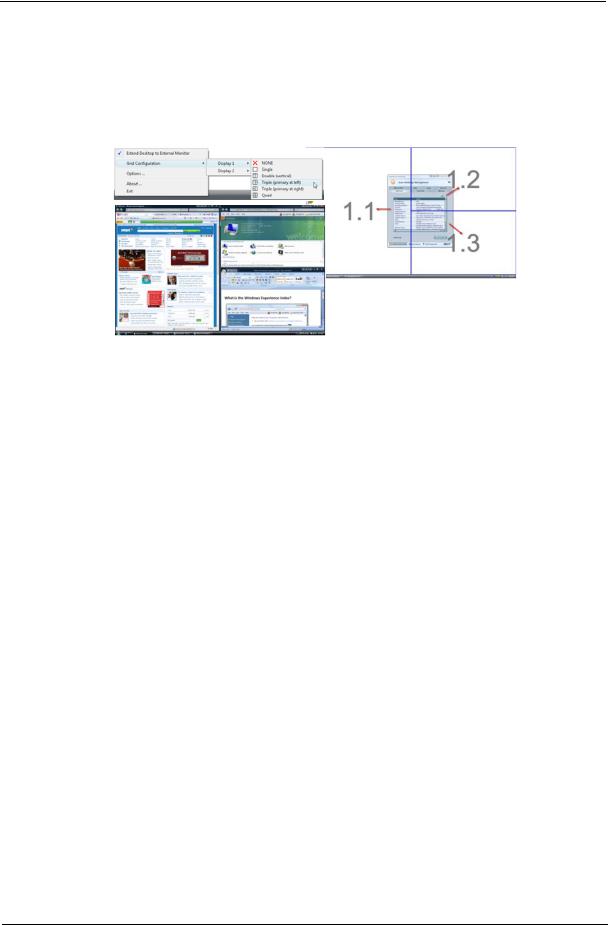
Double (vertical), Triple (primary at left), Triple (primary at right), or Quad Acer Gridvista is dual-display compatible, allowing two displays to be partitioned independently.
Acer Gridvista is dual-display compatible, allowing two displays to be partitioned independently. AcerGridVista is simple to set up:
1.Run Acer GridVista and select your preferred screen configuration for each display from the task bar.
2.Drag and drop each window into the appropriate grid.
3.Enjoy the convenience of a well-organized desktop.
NOTE: Please ensure that the resolution setting of the second monitor is set to the manufacturer's recommended value.
Chapter 1 |
17 |

Hardware Specifications and Configurations
Processor
Item |
|
|
Specification |
|
|
|
|
|
|
CPU type |
|
AMD CPU S1g2 Processor (Griffin Series - Turion / Sempron); |
||
|
|
|
HT3 (1.2~2.6GT/s) (Bandwidth: 9.6GB/S to 20.8GB/s) |
|
|
|
|
1.8GHz ~ 2.3GHz CPU |
|
|
|
|
Integrated 64bit or 128-bit DDR2 SDRAM controller |
|
|
|
|
One HyperTransport™ link to I/O devices |
|
|
|
|
One link, 16 bits in each direction, supporting speeds up to |
|
|
|
|
800MHz (1.2GT/s) or 2.6Gigabytes/s in each direction |
|
|
|
|
L2 Cache 256Kb, 512Kb, or 1Mbytes |
|
|
|
|
The processor bus interfaces—HyperTransport 3 technology link |
|
|
|
|
and DDR2 memory—are both source-synchronous |
|
|
|
|
Supports up to 2 unbuffered SO-DIMMs |
|
|
|
|
128-bit DDR2 SDRAM controller operating at up to 333MHz |
|
|
|
|
|
|
Core logic |
|
nVidia MCP77MH (North Bridge + South Bridge) |
||
|
|
|
|
|
CPU package |
|
638-Pin Lidless Micro PGA package (35mm x 35mm) |
||
|
|
|
|
|
CPU core voltage |
|
VCC_CORE0(based on CPU) |
||
|
|
|
VCC_CORE1(based on CPU) |
|
|
|
|
CPU)VDDNB(based on CPU) |
|
|
|
|
VLDT 1.2V_HT |
|
|
|
|
VDD i/O 1.8VSUS |
|
|
|
|
CPU Memory Interface SMDDR_VTEM(0.9V) |
|
|
|
|
|
|
CPU Fan True Value Table |
|
|
||
|
|
|
|
|
DTS (degree C°) |
|
Active Fan Speed (rpm) |
|
|
|
|
|
|
|
56-64 |
|
2900 |
|
|
|
|
|
|
|
65-74 |
|
3300 |
|
|
|
|
|
|
|
75-84 |
|
3700 |
|
|
|
|
|
|
|
>85 |
|
4000 |
|
|
|
|
|
|
|
BIOS |
|
|
|
|
|
|
|
|
|
Item |
|
|
Specification |
|
|
|
|
||
BIOS vendor |
|
Phoenix |
||
BIOS Version |
|
V1.3333 |
||
|
|
|
||
BIOS ROM type |
|
W25X80VSSIG |
||
|
|
|
||
BIOS ROM size |
|
1Mbyte (8Mbit) |
||
|
|
|
||
BIOS package |
|
8-pin SOIC |
||
|
|
|
||
Supported protocols |
|
SPI |
||
|
|
|||
BIOS password control |
Set by setup manual |
|||
|
|
|
|
|
Cache |
|
|
|
|
|
|
|
|
|
Item |
|
|
Specification |
|
|
|
|
||
Cache controller |
|
Non |
||
|
|
|
||
Cache size |
|
256Kb, 512kb, or 1Mbytes |
||
|
|
|
|
|
18 |
Chapter 1 |

System Memory
Item |
Specification |
|
|
|
|
Memory controller |
Integrated with MCP77MH chipset |
|
Memory size |
0MB (no on-board memory) |
|
|
|
|
DIMM socket number |
2 sockets |
|
|
|
|
Supports memory size per socket |
2 GB |
|
|
|
|
Supports maximum memory size |
4GB for 64bit OS (with two 2 GB SODIMM) |
|
|
|
|
Supports DIMM type |
DDR 2 Synchronous DRAM |
|
|
|
|
Supports DIMM Speed |
533/667 MHz |
|
|
|
|
Supports DIMM voltage |
1.8V |
|
|
|
|
Supports DIMM package |
200-pin DDR2-533/667 soDIMM |
|
|
|
|
Memory module combinations |
You can install memory modules in any combinations as long as |
|
|
they match the above specifications. |
|
|
|
|
Memory Combinations |
|
|
|
|
|
Slot 1 |
Slot 2 |
Total Memory |
|
|
|
0MB |
512MB |
512MB |
|
|
|
0MB |
1024MB |
1024MB |
|
|
|
0MB |
2048MB |
2048MB |
|
|
|
512MB |
512MB |
1024MB |
|
|
|
512MB |
1024MB |
1536MB |
|
|
|
512MB |
2048MB |
2560MB |
|
|
|
1024MB |
0MB |
1024MB |
|
|
|
1024MB |
512MB |
1536MB |
|
|
|
1024MB |
1024MB |
2048MB |
|
|
|
1024MB |
2048MB |
3072MB |
|
|
|
2048MB |
0MB |
2048MB |
|
|
|
2048MB |
512MB |
2560MB |
|
|
|
2048MB |
1024MB |
3072MB |
|
|
|
2048MB |
2048MB |
4096MB |
|
|
|
NOTE: Above table lists some system memory configurations. You may combine DIMMs with various capacities to form other combinations. On above table, the configuration of slot 1 and slot 2 could be reversed.
Chapter 1 |
19 |

LAN Interface
|
|
Item |
|
|
|
|
|
Specification |
|
|
|
|
|
|
|
|
|
|
|
||
LAN Chipset |
|
|
Broadcom BCM5764M / BCM5787M |
|
|
|||||
Supports LAN protocol |
|
10/100/1000 Mbps |
|
|
|
|||||
|
|
|
|
|
|
|
|
|
|
|
LAN connector type |
|
RJ45 |
|
|
|
|
|
|
||
|
|
|
|
|
|
|
|
|
|
|
LAN connector location |
|
Left side |
|
|
|
|||||
|
|
|
|
|
|
|
|
|
|
|
Features |
|
|
PCIE v1.1 compliant |
|
|
|
||||
|
|
|
|
Support Wake-On-Lan |
|
|
|
|||
|
|
|
|
Self-boot feature, utilizing smaller EEPROM size |
||||||
|
|
|
|
Serial flash memory support |
|
|
||||
|
|
|
|
SMBus interface supporting Alert Standard Format (ASF) v2.0 |
||||||
|
|
|
|
Hot plug support |
|
|
|
|||
|
|
|
|
PCI Express CLKREQ support |
|
|
||||
|
|
|
|
Energy Detect/Cable Sense |
|
|
||||
|
|
|
|
Unbuffered serial flash memory support |
|
|
||||
|
|
|
|
Integrated serial debug interface to ease system-level |
||||||
|
|
|
|
debugging |
|
|
|
|||
|
|
|
|
|
|
|
|
|
|
|
Bluetooth Interface |
|
|
|
|
|
|
|
|
||
|
|
|
|
|
|
|
|
|
|
|
|
|
Item |
|
|
|
|
|
Specification |
|
|
|
|
|
|
|
|
|
|
|
||
Chipset |
|
|
Broadcom BCN2045NMD |
|
|
|||||
|
|
|
|
• |
Internal Mini USB I/F solution with antenna |
|||||
|
|
|
|
• |
Bluetooth 2.0+EDR |
|
|
|||
|
|
|
|
• |
8 wires connector for system |
|
|
|||
|
|
|
|
|
|
|
|
|
||
Data throughput |
|
|
Support 3Mbps enhanced data rate |
|
|
|||||
|
|
|
|
|
|
|
|
|
|
|
Protocol |
|
|
802.15.1 |
|
|
|
|
|||
|
|
|
|
|
|
|
|
|
||
Interface |
|
|
Universal Serial Bus(USB) |
|
|
|||||
|
|
|
|
|
|
|
|
|
||
Connector type |
|
|
SMT-S-F-0.8mm(SM08B-SURS-TF(CF) JST |
|||||||
|
|
|
|
|
|
|
|
|
|
|
Wireless Module 802.11b/g |
|
|
|
|
|
|
|
|
||
|
|
|
|
|
|
|
|
|
|
|
|
|
Item |
|
|
|
|
|
Specification |
|
|
|
|
|
|
|
|
|
|
|
|
|
Chipset |
|
|
Atheros AR2425 |
|
|
|
||||
Data throughput |
|
|
• 802.11b : 11Mbps with fall back rates of 5.5, 2, and |
|||||||
|
|
|
|
|
1Mbps |
|
|
|
||
|
|
|
|
• |
802.11g : 54 Mbps with fall back rates of 48, 36, 24, |
|||||
|
|
|
|
|
18, 1, 9, and 6Mbps |
|
|
|||
|
|
|
|
|
|
|
|
|
|
|
Protocol |
|
|
802.11a/b/g |
|
|
|
||||
|
|
|
|
|
|
|
|
|
||
Interface |
|
|
PCI-Express bus (mini PCI socket for wireless module) |
|||||||
|
|
|
|
|
|
|
|
|
|
|
Hard Disk Drive Interface |
|
|
|
|
|
|
|
|
||
|
|
|
|
|
|
|
|
|
|
|
|
Item |
|
|
|
|
Specifications |
|
|
|
|
|
|
|
|
|
|
|
|
|
|
|
|
Vendor & |
Hitachi |
Segate |
|
Toshiba |
|
WD |
WD |
|
|
|
Model |
5K250-250 |
ST9160827AS |
|
MK2546GSX |
|
WD2500BEVS |
WD3200BEVT |
|
|
|
Name |
5K250-160 |
ST9120817AS |
|
MK1646GSX |
|
WD1200BEVS |
WD1600BEVT |
|
|
|
|
5K250-120 |
|
|
|
MK1246GSX |
|
|
|
|
|
|
|
|
|
|
|
|
|
|
|
|
Capacity |
250, 160, 120 |
160, 120 |
|
250, 160, |
|
250, 120 |
320,160 |
|
|
|
(MB) |
|
|
|
|
120 |
|
|
|
|
|
|
|
|
|
|
|
|
|
|
|
|
Bytes per |
512 |
512 |
|
|
512 |
|
512 |
512 |
|
|
sector |
|
|
|
|
|
|
|
|
|
|
|
|
|
|
|
|
|
|
|
|
|
Data heads |
4, 3, 2 |
3, 2 |
|
|
4, 3, 2 |
|
4, 2 |
4, 2 |
|
|
|
|
|
|
|
|
|
|
|
|
20 |
Chapter 1 |
